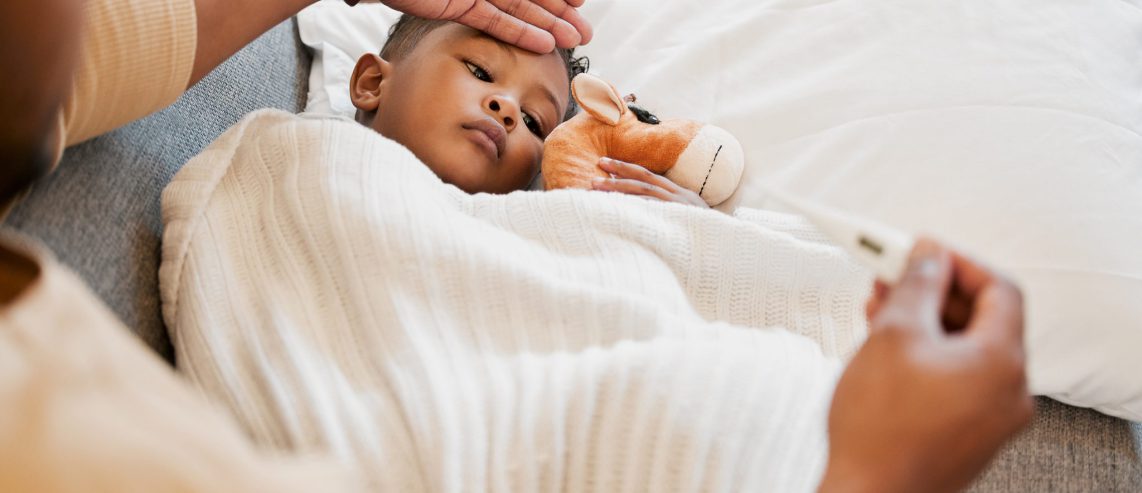When you have a fever, you feel achy, chilled, and tired. You want the fever to break so you feel normal again.
But should you try to break a fever? What’s the best way to bring down a fever? Here’s what you need to know about how to get rid of a fever, and when you should call the doctor.
What Is a Fever?
A fever is an increase in your body’s temperature. It’s often the first response to an illness or disease. The temperature increase is temporary and goes back down when you’re feeling better.
A fever is not a disease. Rather, it is a symptom that something else is wrong in your body.
Having a fever often means that your body is fighting an infection. When your body temperature is higher than normal, it’s harder for the bacteria and viruses that cause illness to survive.
Individual body temperatures can vary. What’s normal for one person might be low for another. But doctors typically say an adult or child has a fever if their temperature is over 99.5 degrees Fahrenheit.
Never Miss a Beat!
Subscribe to Our HealthBeat Newsletter!
Thank you for subscribing!
You can now select the specific newsletters you'd like to receive.
You are already subscribed.
Subscribe to more newsletters in our email preference center.
Sorry, an error occurred. Please try again later.
Get Healthy Tips Sent to Your Phone!
What Affects Your Temperature?
A wide range of factors, other than being sick, can affect your body temperature. For instance, your temperature can vary depending on the time of day. It’s usually higher in the evening than in the morning.
For children, temperature can vary depending what method you use to take it. A rectal temperature might be slightly different from one taken in the armpit or ear.
Other things that can affect body temperature:
- Heavy clothing.
- High humidity.
- High room temperature.
- Medicines.
- Physical activity.
- Strong emotions.
- Your menstrual cycle.
Should You Try to Break a Fever?
You don’t necessarily have to “break” a fever. A fever in and of itself is usually not dangerous, especially if it’s not very high and you have a mild illness. And because a fever may be fighting infection, doctors sometimes recommend letting the fever run its course.
But a fever can make you feel miserable. And if a young child has a fever, they can feel even worse — cranky, achy, and unable to sleep well. It’s understandable that you want to get rid of the fever as quickly as possible.
How to Break a Fever
There are several ways to help safely bring down a fever. You can:
- Apply cool compresses. Wet a washcloth with cold water and wring it out. Place it on your forehead or wrists to help you feel more comfortable and bring the fever down.
- Get plenty of rest. Your body needs to rejuvenate in order to fight an infection and accompanying fever. If you can’t sleep, at least snuggle up with a book, podcast, or movie and take it easy.
- Stay hydrated. Drinking plenty of fluids will help cool your body and keep you from getting dehydrated, a common problem with fever. Don’t drink caffeinated beverages, which can make you pee more and lead to dehydration.
- Take over-the-counter (OTC) pain relievers. Ibuprofen or acetaminophen can relieve head and body aches and lower your temperature. Check with your pediatrician before giving your child any pain medicine.
- Wear comfortable, breathable clothing. If you’re chilled, it’s tempting to bundle up in heavy clothes and blankets. But getting overheated can make your fever worse.
What You Shouldn’t Do to Bring Down a Fever
There are plenty of myths about how to bring down a fever — and some of them are dangerous. You should never:
- Immerse yourself or your child in an ice bath. It doesn’t bring relief from the fever and can drop your body temperature too low. You or your child could be at risk for hypothermia.
- Try to “sweat it out”. If you wrap up in too many blankets, you may raise your body temperature even higher. And don’t over-bundle a sick child; babies can’t regulate their body temperatures as well as adults.
- Use aspirin to treat a child’s fever. It could have side effects like upset stomach and intestinal bleeding. Aspirin use in children can also lead to Reye syndrome, a serious illness that affects the liver and brain.
- Use rubbing alcohol on the body. Some people mistakenly believe that rubbing alcohol can cool your skin and bring down a fever. But it can get absorbed into the skin or inhaled, causing serious conditions, such as coma, in children.
When Should You Seek Medical Help for a Fever?
There are times when a fever is a sign of a more serious problem. You should call the doctor if:
- A baby under three months old has a fever. It could be a sign of a serious disease, like meningitis.
- An adult has a fever of 104 degrees or higher.
- The fever lasts beyond four or five days.
- You have a fever and a weakened immune system, from a disease like AIDS or diabetes, or from going through cancer treatment.
- You have persistent vomiting and diarrhea with the fever.
- You or your child has a fever and has stopped peeing, which is a sign of dehydration.
- Your baby has a fever and is either lethargic or very fussy.
- Your child has a fever and isn’t shedding tears when they cry, another sign of dehydration.
- Please note that it is common to have some fever and aches after vaccinations; this does not mean allergy, it simply means that your body is responding the desired immune response and developing protective immunity. You can use acetaminophen or ibuprofen to bring the temperature down if needed. Such a reaction should not dissuade you from receiving the same or other vaccines in the future.
When to seek immediate help
If you have a fever along with any of the symptoms below, you should go immediately to the emergency room.
- Confusion.
- Light sensitivity.
- Loss of consciousness.
- Pain when urinating or urine that smells bad.
- Severe headache.
- Severe pain anywhere in the body.
- Shortness of breath.
- Stiff neck.
- Swelling or inflammation anywhere in the body.
- Trouble breathing.
Preventing Fevers
You can’t prevent every illness and fever from happening. But you can protect yourself as much as possible. Here’s how:
- Avoid touching your eyes, nose, and mouth with your hands.
- Don’t share cups, glasses, or cutlery with anyone.
- Get the recommended vaccines for your age. That includes routine childhood vaccines, COVID-19 vaccines, and adult shots, like the shingles vaccine.
- Use good hygiene. Wash your hands after using the bathroom, eating, or being around large groups of people.
- In hot weather, one should dress appropriately, wearing light clothing, and if involved in sport or exercise take more frequent breaks for hydration, especially if receiving any kind of medications that can impair sweating (especially medications for significant behavioral conditions.)
Sources
American Academy of Pediatrics, Treating Your Child's Fever, Link
National Library of Medicine, Fever, Link
Kidshealth.org, Fever (High Temperature) in Kids, Link
U.S. News & World Report, Best Ways to Bring Down a Fever, Link
Harvard Publishing, Fever in adults: When to worry, Link
NHS, High temperature (fever) in adults, Link
About UPMC
Headquartered in Pittsburgh, UPMC is a world-renowned health care provider and insurer. We operate 40 hospitals and 800 doctors’ offices and outpatient centers, with locations throughout Pennsylvania, Maryland, New York, West Virginia, and internationally. We employ 4,900 physicians, and we are leaders in clinical care, groundbreaking research, and treatment breakthroughs. U.S. News & World Report consistently ranks UPMC Presbyterian Shadyside as one of the nation’s best hospitals in many specialties and ranks UPMC Children’s Hospital of Pittsburgh on its Honor Roll of America’s Best Children’s Hospitals. We are dedicated to providing Life Changing Medicine to our communities.

